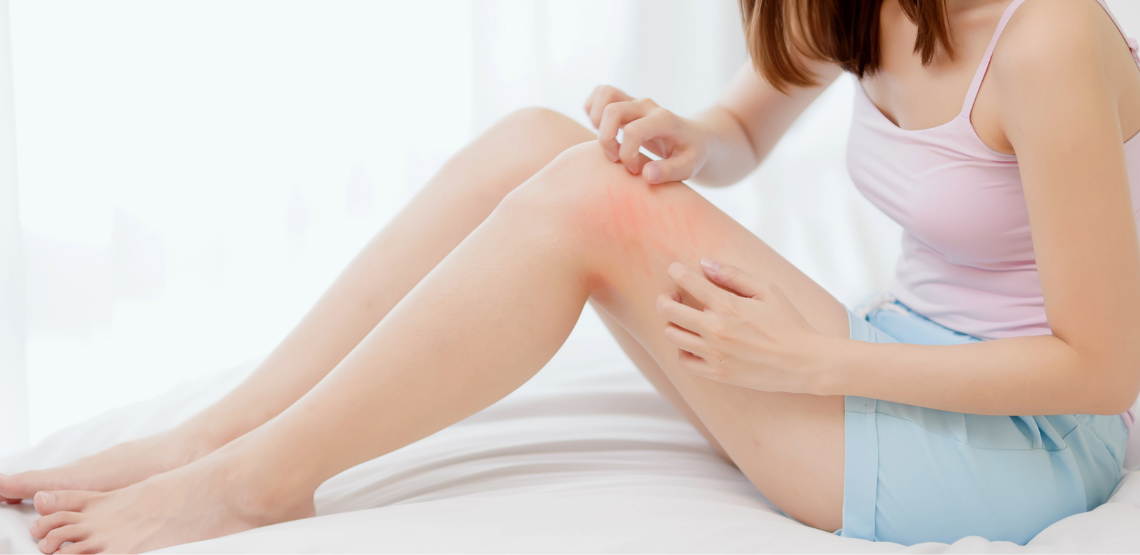What is Petechiae?
Linking small arteries and veins are tiny, delicate blood vessels called capillaries. When these capillaries bleed, they leak blood into the skin and cause red, purple, or brown spots. The spots are typically very small, not larger than the head of a pin. These tiny colored dots are called petechiae.
If you’ve ever carried a heavy shoulder bag or suffered an abrasion from rough fabric, you may have noticed petechiae on your skin. Because capillaries can break from pressure or injury, we see petechiae most often when our skin undergoes some damage.
Although petechiae can occur anywhere on the body, it most commonly appears on the stomach, waist, arms, legs, or buttocks — areas that are more prone to injury from clothing or the environment. Sometimes, petechiae may appear on the fragile skin of the eyelids or the inside of the mouth.
Most instances of petechiae aren't a medical emergency and the spots usually disappear on their own. In rare instances, however, petechiae can signal a serious condition. Because some causes might be a sign of something critical, it’s essential to know what to look out for.
9 Common Causes of Petechiae
A variety of factors may cause petechiae, so knowing which risks most likely apply to your situation can make all the difference. The following are a few of the most common or high-risk causes of petechiae.
1. Injuries
Injuries are the most frequent causes of petechiae.
Friction or blunt force trauma can cause capillaries to burst, resulting in the distinct spotting of petechiae. For example, carrying a heavy backpack might cause petechiae when the straps press into the skin.
A sunburn may also cause capillaries to pop, turning into petechiae.
2. Straining
Physical activities that cause you to strain can cause capillaries to burst, resulting in petechiae. Lifting weights, coughing, bearing down during birth or a bowel movement, and vomiting can all cause petechiae.
3. Strep Throat
Strep throat is caused by a bacterial infection from group A Streptococcus.
Most people are familiar with strep throat’s symptoms: swollen glands, fever, body aches, fatigue, swollen tonsils, and pain when swallowing. However, red spots of petechiae on the roof of the mouth are a hallmark symptom of strep throat.
4. Thrombocytopenia
Individuals with thrombocytopenia have too few blood platelets that allow blood to clot effectively. Because of this lack of platelets, they may bleed and bruise easily, have frequent nosebleeds, and frequently experience petechiae on their skin.
5. Mononucleosis
Mononucleosis, more commonly known as mono, is a viral infection shared through bodily fluids, namely saliva.
More commonly occurring in young people, mono’s symptoms are swollen glands, sore throat, fever, headache, and swollen tonsils. Petechiae may appear on the roof of the mouth and throughout the body.
6. Rocky Mountain Spotted Fever
Rocky Mountain spotted fever, known as RMSF, is a potentially life-threatening bacterial infection transmitted by ticks during the summer months.
If left untreated, the mortality rate for RMSF is 70%. Early medical intervention can reduce the rate to 0.5%; therefore, early identification is essential.
Symptoms of RMSF are high fever, a painful headache, nausea, vomiting, and petechiae.
7. Leukemia
Leukemia is a cancer of the blood and bone marrow, which affects how blood clots. Symptoms of leukemia include swollen glands, fever, unexplained weight loss, nosebleeds, bruising, and petechiae.
8. Sepsis
Sepsis is a blood infection by bacteria and is a life-threatening condition. The symptoms include a high fever, rapid heart rate, and difficulty breathing.
Petechiae on the skin is frequently found in cases of sepsis, sometimes spreading throughout the body.
9. Medication
Some medications may cause petechiae as a side-effect. For instance, blood thinners, antibiotics, antidepressants, and nonsteroidal anti-inflammatory drugs (NSAIDs) may produce petechiae.
Symptoms and Treatments
Unlike a bruise, which covers a larger skin area, petechiae appear as small clusters of spots. Petechiae is often mistaken for a rash, but it really stems from burst capillaries under the skin.
One way to differentiate between a rash and petechiae is to press on them. When subjected to pressure, a rash will blanch and become white. Petechiae, on the other hand, remains the same color.
For petechiae due to injury or straining, staying hydrated and resting after an injury can help speed up the healing process.
Petechiae that’s possibly caused by medication should be assessed by a doctor, especially if a person has recently started a new drug treatment.
When to Seek Help
Most infection-related petechiae heals when the infection gets better. However, see a doctor right away if your petechiae are accompanied by the following:
- High fever
- Rapid heart rate
- Changes in heart rate
- Shortness of breath
- Excessive fatigue
- Other skin changes
- Petechiae spreads or becomes larger
In events where petechiae are caused by straining or injury, the petechiae eventually heal and go away. In most cases, petechiae resolve on their own without harm.

